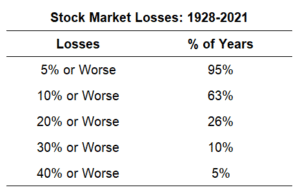The stock market has been a little bit crazy the past couple of weeks. There has been a lot of volatility (rapid ups and downs) and many indexes and individual stocks are seeing losses.

As I’m writing this, the Nasdaq 100 (an index made up of the 100 largest U.S. stocks) is down 15% since January 1st. Small-cap stocks are down around 14% as well. What’s really causing people to worry is that many of the popular, large tech stocks that everyone has purchased over the past few years have been plummeting. Just this year:
• GameStop is down 38%
• Netflix is down 35%
• Tesla is down 28%
• Nvidia is down 26%
• Amazon is down 17%
• Apple is down 12%
• Bitcoin is also down around 50% from its highs
While many of the popular stocks in the index are dropping, the S&P 500 as a whole is still only down around 8%. In the grand scheme of things, this drop is relatively small. But given that the biggest correction in the S&P 500 last year was just 5.2%, I can understand why people are concerned. It’s been a while since there’s been some volatility in the market.
So, I figured now is a good time for a reminder that drawdowns, as we’ve seen recently, happen from time to time in the stock market.

The only reason you can get returns over the long run is because you occasionally experience losses in the short run. This is a feature of the stock market, not a bug.
This chart from Ben Carlson looks at how often the U.S. stock market has experienced the following losses:

As you can see, corrections of 10% or more in the S&P 500 have happened in 63% of all years. And the average drawdown (price drop from peak to trough) over the course of a calendar year is 13.6%. Over the last 94 years, there has been a double-digit correction at some point during the year more often than not.
• On average, the U.S. stock market has experienced:
• A correction once every 2 years (10%+)
• A bear market once every 7 years (20%+)
• A crash once every 12 years (30%+)
Obviously, these things don’t happen on a set schedule. The point of the data is to show that market corrections, and even crashes, are normal.
Despite these regular drawdowns, the S&P 500 is still up 7,670% since 1980.
Watching your portfolio decrease in value is never fun. Volatility can take a psychological toll on investors and increase the possibility of making a mistake.
But if you’re a long-term investor and invest on a regular basis, these corrections are actually a good thing. They mean you get to buy stocks on sale. If you have a long time horizon you should prefer down markets because you can buy when prices are low, which will lead to better returns over the long haul.
If you’re stressed right now because you don’t have a long time horizon and invested money you may need soon, well, you should have never invested that money in the first place.

Could this correction get worse? Sure. Could it also bounce back and hit new highs? Yep, it could. Some people are saying stocks will dip further because of the Fed, or inflation, or interest rates, or geopolitics, or any number of other variables.
Those conversations can be intellectually stimulating for some, but the truth is the reasons don’t matter. Sometimes stocks go down. This isn’t groundbreaking news. Market corrections are perfectly normal.
Your investment strategy should be durable enough to handle both up and down markets.
Thanks for reading!

